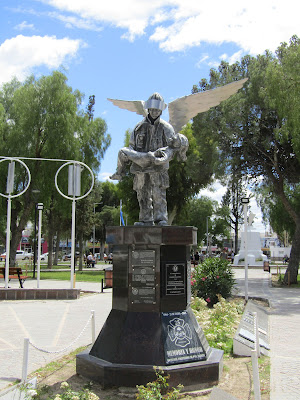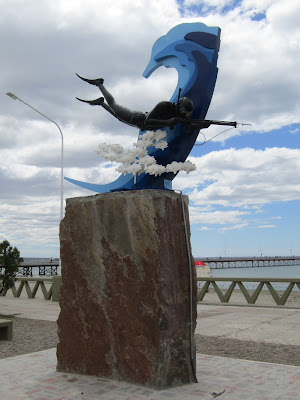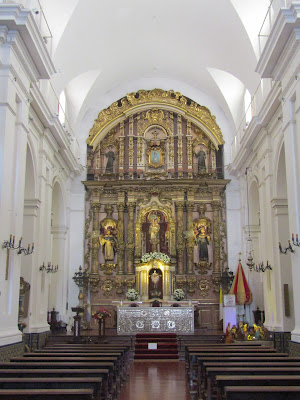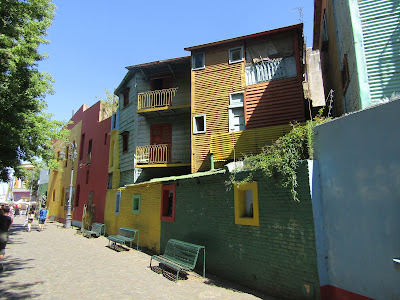Puerto Madryn, Argentina
The temperature was a delightful 22°C for our walk into and around Puerto Madryn. We joined Rob and
Gwen (from Aberdeen) and found the Natural Science and Oceanographic Museum,
housed in a once prestigious home which was built in 1915. The exhibits were attractive
and informative and the turret provided extensive views of the city and bay.
We then walked several blocks to the main plaza area which
is bordered on one side by Australian Eucalypts and faces a very pretty
Catholic church. In the plaza we saw a fitting memorial to the volunteer fire
brigade whose activities began 25 years ago this year. It was then time for
coffee, so we found the Panaderia Valentina bakery, Puerto
Madryn’s answer to Banjos, and had good coffee and mouth-watering pastries.
Penny and Gwen were in need of some retail therapy so
stopped in at a farmacia, a boutique, window shopped at Penelope
Glamour and a kitchenware shop and wandered through craft markets on our way
back to the ship. Along the foreshore we saw a fabulous sculpture of a scuba
diver from yet another talented Argentinian artisan.
In the early hours of Tuesday 17 December, there was a
passenger medical emergency on board. As we were already too far out to sea and
a rescue helicopter was unavailable the Captain made the decision to turn back
to Puerto Madryn. This necessitated the cancellation of our first Uruguayan
port, Punta del Este, and the addition of a sea day before our arrival in
Montevideo.
The museum
Mara - rodent smaller than a Capybara
Jim with a Rhea - an emu like bird
Stairs up to the turret
View from the turret
Memorial to Volunteer Fire Fighters
Eucalypt trees
Valentina Cafe
At 1.5 million people, capital city Montevideo is home to one-third
of the population of Uruguay and is considered to be in the top five cities of the
Americas. We started out early and spent hours walking through the city,
beginning in the old town. There the narrow roads are paved with cobblestones
and characterful buildings are looking a little tired but there are plenty of
outdoor cafes and local artesans selling their wares.
At one of the many craft stalls that line the roads, Penny
bought a maté
kit. This consists of a hollowed-out gourd used as a receptable for a bitter
local herbal concoction known as maté, and a metal straw
called a bombera which has a strainer at one end to keep the leaves at
bay. We stopped in at the Plaza Zabala with its wonderful statue before
continuing on to the newer part of the city.
There we wandered through the Plaza Constitución with its rows of second-hand
and antique market stalls - right opposite Starbucks and McDonalds. The Sarandi
Pedestrian Street Shopping Mall is full of beautiful homewares shops, boutiques
and cafes and we stopped in at the El Copacabana Restaurante for good
strong coffee and tea which is served with a small glass of sparkling mineral water,
a tube of freshly squeezed orange juice and a small biscuit. Delightful.
At the entrance to the huge Plaza Independencia is
the Puerto de la Ciudadela, the enormous gate of the original Citadel of
Montevideo built in 1741. And behind it is a most impressive and interesting
historic building that looks like something out of a fantasy movie. After
walking back to the port area, we lunched at Il iaia restaurant on fresh
salads and a glass of Uruguayan Cab Sav whilst listening to live local music.
By then we had been on the go for five hours so took our weary feet back to the
ship.
Ship graveyard at Montevideo
In the old town
Plaza Zabala
In the new town
We saw several security guards with interesting weapons
Cannabis shop
Lunch at Il Iaia
Buenos Aires, Argentina
Buenos Aires’ population, at 15 million, is a staggering
half of the entire country of Argentina. On our first day, it was through crowded
streets that we walked from the port via the enormous railway station to the
CBD, in the wind and rain. On the way we passed the Torre Monumental, a
75.5 metre clock tower gifted by the British community to commemorate the
centenary of the revolution of 1810.
We finally found refuge from the rain at Starbucks and then
walked back up and down the picturesque shopping mall before heading back to
the ship. Thankfully the wind had subsided, but not the rain…
On our first day off the ship in Buenos Aires, we wandered
out for lunch in the Recoleta district and came across a series of wonderful
plazas full of restaurants and markets stalls. We also happened upon the Recoleta
Cemetery. built in 1822, where lies the remains of political leaders and presidents, Nobel Prize winners and famous athletes, writers and businessmen. Eva Peron is the most famous of those
interred and the sheer size and opulence of the mausoleums is astounding.
Beside the cemetery is the beautiful Our Lady of Pilar Basilica, built in 1732, with its wonderful cloisters. These vaulted ceiling-ed rooms were used as the access point to the bell tower, storage and as cells for the friars during the building of the attached convent. The cloisters now form a museum of priceless paintings, gold and silverware and mannequins dressed as religious figures.
The Recoleta Cemetery
Our Lady of Pilar Basilica
Inside the Cloisters
One of the world's first cat doors (yes, actually)
Enormous rubber trees in the plazas
We also saw the city’s obelisk which commemorates 400 years of the foundation of Buenos Aires. It is 67.5 metres tall and was constructed
by a German company whose 157 workers used quick setting cement to complete the
job in just 31 days, back in 1936. The La Boca district is famous for tango,
and we wandered down Caminito Street with its multi-coloured buildings and quirky
shopfronts. There were dancers in the restaurants but no tango (we have seen
many locals teaching tourists how to tango). This whole area was settled by
immigrants who built shanty-type houses. And because they had no money they
would go down to the docks and ask for leftover paints, which explains why the
houses were multi-coloured, and through tradition still are.
The Obelisk
Casa Rosado
Buenos Aires Cathedral
La Boca
Puente de la Mujer (Woman's Bridge) which is a rotating footbridge
that swings to allow boats through
On our third day we took a long walk from the hotel through the surrounding streets and leafy avenues to the marvellous Ateneo Grand Splendid. Previously a very grand theatre, it was re-purposed in 2000 as a bookstore which holds some 250,000 books. Several years ago it was nominated as the second most beautiful bookstore in the world. After wandering through, and up into the balconies, we had coffee and croissants in the café which is located on the former stage.
On the streets of Buenos Aires
Ateneo Grand Splendid
The magnificent domed ceiling
The old stage lighting switches now part of the cafe
Children's books are in the basement; there is a ground floor and three balconies
Back at the hotel we made ourselves comfortable in the mezzanine
lounge whilst we waited for our shuttle to the airport.
After 13 hours in the air we finally landed at Auckland International Airport at 5.00am on Christmas Day. And we had a wonderful Christmas Day luncheon at the Grand Mercure Hotel, overlooking Auckland Harbour - a fitting way to end our travels!






















































































